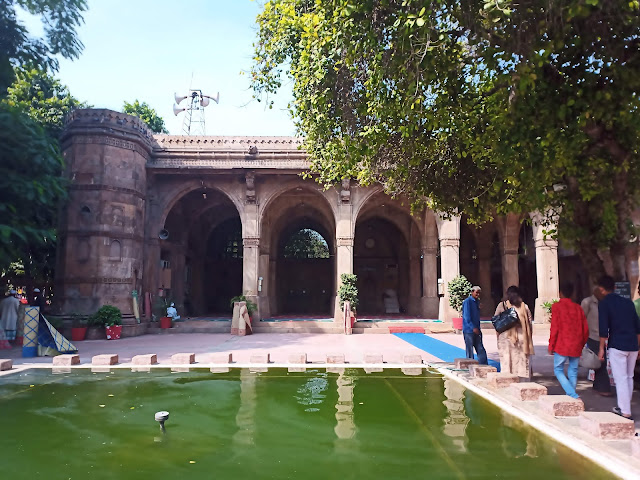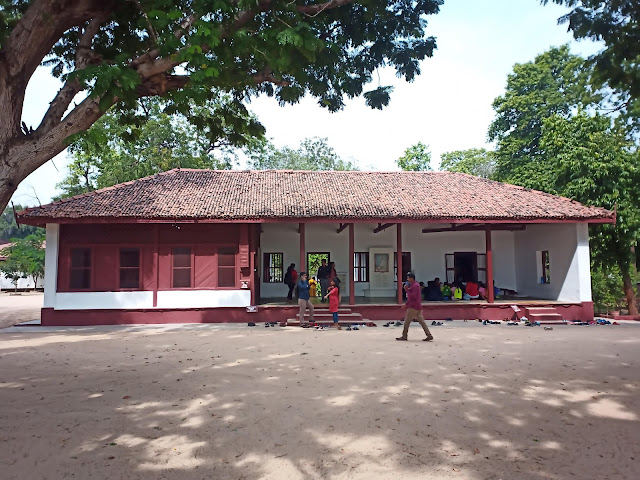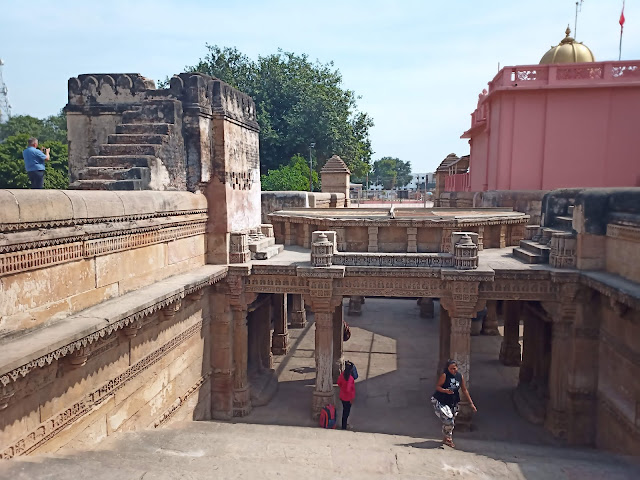An Archaeologist's Guide to Gujarat, India: Ahmedabad
Leaving
Bhuj, my last stop in Gujarat was Ahmedabad, the largest city within
the state and the former state capital. The Ahmedabad area has been
inhabited since the 11th century and has been occupied by various
dynasties, including Mahmud Begada in the late 15th century who was the most prominent Sultan of the Gujarat Sultanate, and the Mughal emperor Humayun
in the early 16th century (see Archaeology of Delhi), followed later by Akbar
and Shahjahan who turned the city into a great trade hub in the 17th
century, trading a range of goods including textiles.
Lalbhai Dalpatbhai Museum
The
Lalbhai Dalpatbhai Museum houses an extensive collection of Indian art,
including sculptures, bronzes, paintings, drawings, coinage, woodwork
and beadwork. Visitors are met with an array of information about Hindu
and Buddhist mythology, and shown the great breadth of art from the
Indian subcontinent. The museum is open daily from 10:30am to 5:30pm,
except for Monday, and entry is free.
 |
| Ahmedabad Tourism (https://ahmedabadtourism.in/lalbhai-dalpatbhai-museum-ahmedabad) |
The Old City
The
Sidi Saiyyeh Mosque is located within the historic centre of Ahmedabad,
east of the Sabarmati River, and was constructed in 1572-73 CE. The
mosque is small, but is famous for its intricate lattice-work screens
depicting trees and geometric designs. Women are not permitted to enter
the covered area within the mosque, but can observe from the courtyard.
As with all mosques, visitors are required to remove footwear at the
threshold.
Just
south of the mosque is the Bhadra Fort, built by Ahmad Shah, a sultan of the Muzaffarid dyansty in Gujarat, in 1411. The fort is part of the centre of the old walled city of Ahmedabad, and contained luxurious palaces, residences and mosques. Following its capture by the British, it was used as a prison until the independence of India was established.
Today Bhadra Fort is surrounded by the bustle of the modern city. Colourful markets pepper the area around the fort, with stalls selling fruit, flowers, clothes, and all manner of other items. According to the Ahmedabad tourism website, the fort is open daily and is free to enter. However, during my visit I walked around the south end of the fort and found the local court buildings surrounded by guards. Instead, I continued on through the old city.
Today Bhadra Fort is surrounded by the bustle of the modern city. Colourful markets pepper the area around the fort, with stalls selling fruit, flowers, clothes, and all manner of other items. According to the Ahmedabad tourism website, the fort is open daily and is free to enter. However, during my visit I walked around the south end of the fort and found the local court buildings surrounded by guards. Instead, I continued on through the old city.
Continuing
east down the main market street is the Sidi Bashir Masjid, known as
the Shaking Minarets, just north of the Ahmedabad Junction train
station. The mosque is no longer intact, destroyed during a war between
the Marathas and the Khan of Gujarat sultanate,
but the iconic double minarets are still standing. The name Shaking
Minarets is attributed to the structure as it is said that the minarets
are seen to be shaking when earthquakes hit the region, with the shaking
of one tower resulting in the vibration of the other. The minarets are
three stories tall and entry is not permitted after there was an incident in the early 1980s where a stampede resulted in the death of many children.
Confusingly,
a few minutes south of the Ahmedabad Junction railway station is
another mosque with a double minaret design. This mosque is still
operational today, and is the mosque that comes up as Sidi Bashir Masjid when searching for the site in Google maps. Instead, the actual minarets are identified as "Brick Minar (Jhulta Minara)" on Google maps.
Hutheesing Jain Temple
Further north of the old city, on the
east of the Sabarmati River, is the most famous Jain temple in
Ahmedabad, the Hutheesing Jain Temple. The temple was built in 1848 and
continues to be managed by the Hutheesing family trust. The Hutheesings
are a prominent old Jain family who have contributed to building several
temples and other structures around Ahmedabad.
The temple is dedicated to Lord Dharmanatha, who was the fifteenth Jain Tirthankar (a saviour and spiritual teacher of dharma).
The two-storeyed building is ornately carved on the exterior. After
removing shoes and leaving personal belongings outside (purses allowed),
visitors can enter the forecourt of the temple. Although photography is
not permitted inside, the interior of the temple is picturesque. An
intricately carved building stands in the middle of the courtyard. Steps
lead up three sides of the building to the shrine and religious
offerings within.
Jainism is a transtheistic religion based on a specific dharma that espouses non-violence, truth and non-attachment, and whose followers take a number of vows to uphold these principles.
My brief visit to the temple was a nice introduction into another of the many faiths in India, with Jainism standing alongside Hinduism and Buddhism as common religions within the nation.
My brief visit to the temple was a nice introduction into another of the many faiths in India, with Jainism standing alongside Hinduism and Buddhism as common religions within the nation.
Sabarmati Ashram
The Sabarmati Ashram
is situated on the west bank of the Sabarmati River in Ahmedabad. The
ashram is open daily to visitors from 8:30am to 6:30pm, and is free of
charge. The suburb of Sabarmati was home for twelve years to Mahatma
Gandhi, his wife Kasturba Gandhi, and some of his followers.
Entering
the grounds of the Ashram from Ashram Road, the site museum is on your
immediate left. This open plan museum details Gandhi's story, from his youth and throughout his life to his eventual
assassination.
Life-like models, both miniature and life-size replicas, depict key scenes of Gandhi's life, and a range of historical photographs of Gandhi, his wife and followers illustrate the stages of his life story.
From this site Gandhi led the Dandi March or Salt March in 1930, an act of non-violent protest or satyagraha against British rule in India and the implementation of a salt tax that the British enforced on the Indian people.
After the museum, visitors can see the house in which Gandhi and Kasturba spent twelve years of their life. The balcony, kitchen and Kasturba's room can be entered, whilst Gandhi's is protected by a screen that visitors eagerly peer into and take photographs through.
At the back of the Ashram site is a view over the Sabarmati River. Visitors can sit on a series of steps leading down towards the riverbank, and take in the serenity of the site. Squirrels dart along pathways and between the leafy trees dotted around the ashram. Although I hadn't initially intended to visit the Sabarmati Ashram when planning my time in Ahmedabad, I enjoyed my visit, which further contextualised for me the modern history of the state of Gujarat and the nation more broadly.
Adalaj Stepwell
Heading north out of Ahmedabad, the Adalaj
Stepwell is about half an hour by car. Although a little out of the
city, this stepwell is a popular tourist attraction in the village of
Adalaj. Upon arriving at the main intersection at which the site is
located, visitors are led around a small Hindu temple and behind to the
main entry for the stepwell.
The stepwell was constructed in 1498 by Queen Rudadevi in memory of her husband Rana Veer Singh of the Vaghelas dynasty,
one of the most historic dynasties of Gujarat. These types of stepwells
were built to collect rainfall during the monsoon season, and were
essential for providing water for daily activities during the dry
period. Wells in the Indian subcontinent go back as far as the Indus
Valley civilisation, whose people built circular brick-lined wells in
many of their ancient cities.
Entry to the stepwell site is 300 rupee for foreigners (about 6 AUD or 4 USD) and the site is open daily. Upon entry, visitors walk down a series of stairs, leading into the centre of the stepwell. The stone architecture of the well keeps the space inside much cooler than the Gujarati aridity of the sunbaked exterior. The stepwell is quite an impressive architectural feat, and a short but worthwhile trip out from Ahmedabad.
Gandhinagar
Heading
north from Adalaj takes you to Gandhinagar, the state capital of
Gujarat. Many of the state's government buildings are located here,
including the Directorate of Archaeology and Museums, Abhilekhagar
(Archives) Bhavan, which is the archaeological governance body for the
state of Gujarat.
Akshardham
The Akshardham temple complex in Gujarat is the older counterpart to the Akshardham in Delhi. Built over thirteen years and completed in 1992, the pink sandstone for the structure was sourced from Rajasthan to the northwest. The temple serves as a tribute to Swaminarayan, a yogi and ascetic who worked throughout his life to revive Hindu practices in the late 18th and early 19th centuries.
In addition to the central temple component, there are a number of exhibition halls that introduce visitors to various aspects of Hinduism with life-size models and audiovisual elements. The complex is open everyday except Monday and daily water shows take place in the evenings. The main temple building is surrounded by lush manicured gardens, with elements of Hindu spiritual teachings incorporated throughout, and a canteen and giftshop are open to visitors.
 |
| By Harsh4101991 - Own work, CC BY-SA 3.0, https://commons.wikimedia.org/w/index.php?curid=21136725 |
Interestingly, when you search for Ahmedabad in Google maps, the first two images that are shown are actually the Akshardham temple in Gandhingar. This initially caused some confusion for me, and doubtless other travellers too.
 |
| Google maps |
In Summary
My visit to Gandhinagar rounded out my trip to Gujarat, which proved itself to be a vibrant and varied state within the broader tapestry of India. Although not necessarily the typical destination that most travellers visit when in India, the cities and sites that I visited were colourful and fascinating with great food and lots to see, making my time in Gujarat very memorable.Tweet
















Comments
Post a Comment